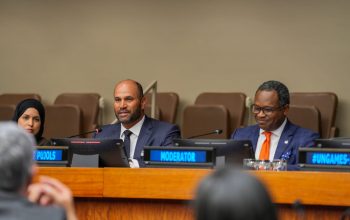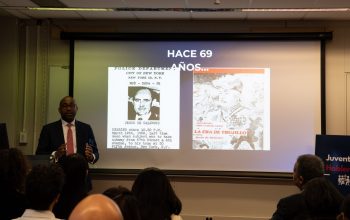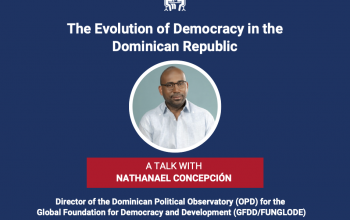news
“Cocaine Production at an All-Time High”, an article by Dr. Leonel Fernández
February 13, 2019
In June 2018, the Office of National Drug Control Policy released a report showing that in the prior year production of coca had reached record levels in Colombia.
As a result, the Trump Administration corresponded with Colombian authorities mandating that they turn the situation around. The President of the United States also threatened to put Colombia on the list of countries that do not take sufficient action to prevent and control the international trafficking of drugs.
More recently, in January 2019, the US Secretary of State, Mike Pompeo, met with the Colombian President, Iván Duque, to reiterate that “the United States remains deeply concerned about the surge in coca cultivation and cocaine production in Colombia since 2013.”
The United Nations World Drug Report 2018 also signaled that since 2013 cocaine production had increased significantly and that in 2017 it had reached historic highs.
According to that report, the total area of coca harvesting increased by 17 percent between 2016 and 2017, equivalent to 250 square kilometers, which corresponds to the entire size of the Barahona province and its 11 municipalities.
That increase alone corresponds to a production of 1,379 tons of cocaine, which has a monetary value of about 2.7 billion dollars.
With about 34 percent of the total market, the United States is the largest consumer of Colombian cocaine. It is no surprise that the increase in production concerns the US government.
Still, according to many experts, it is likely that the Trump Administration has approached the situation with simplicity. To the US government, the fundamental reason for the increase in coca cultivation is the dissident factions of the Revolutionary Armed Forces of Colombia (FARC).
Certainly, a dissenting faction exists, but the most likely cause of the hike in coca cultivation is the power vacuum that resulted from the peace agreements between the FARC and the Colombian government.
Also contributing to the situation is extreme poverty and lack of adequate infrastructure and transportation. Without this, it is difficult for farmers to substitute coca cultivation for legal crops.
The Crop Substitution Plan
The peace agreement between the FARC and the Colombian government is based on six fundamental aspects: rural development; political participation; the end of the conflict; solution to the problem of illicit drugs; agreements for the victims of the conflict; and implementation and verification of the agreement.
As a result of the peace accord, the National Comprehensive Program for the Substitution of Illicit Crops was created. The initiative is the fundamental organism that devises Colombia’s antinarcotic policies.
The objectives of the crop substitution program include the promotion of voluntary substitution of illicit crops through the implementation of substitution and alternative development initiatives, designed in concert with the involved communities.
Second, the program aims to make Colombian territory free of the use of illicit crops, keeping in mind human rights and the environment.
Third, it strengthens the government’s institutional presence in territories impacted by the use of illicit crops.
Fourth, the initiative intends to reduce poverty in rural communities, impacted by the use of illicit crops, by improving conditions in those territories.
After a year of the National Comprehensive Program for the Substitution of Illicit Crops (PNIS), the Fundación Ideas para la Paz (FIP) published a report that lays out the successes and failures of the program.
The report explains that the roll out of the program was slow. Many rural families that knew about the plans began to produce greater amounts of coca so that they would not be excluded from the program, which gives coca farmers 320 dollars every month.
This phenomenon is one of the causes for the tripling of coca cultivation between 2012 and 2016, from 480 to 1,460 square kilometers, which then rose to historic highs in 2017 of 1,700 square kilometers.
Among the government’s aims were to eliminate 500 square kilometers of coca cultivation by forced eradication and another 500 by voluntary crop substitution.
The government began signing contracts with thousands of coca producers, but the plan has not been effective due to the existence of armed groups in the rural areas that are linked to the international drug trafficking and that threaten to kill coca producers if they halt cultivation. There has been an 11 percent increase in homicides among coca farmers and in the past year 226 social leaders supporting the crop substitution plan have been killed.
Despite all of this, the crop substitution plan has been more effective than forced eradication.
To date, 328 square kilometers have been eradicated through the crop substitution efforts.
In the Eye of the Storm
In 2016 the National Directorate for the Control of Drugs (DNCD) agreed with this analysis.
In its own report, the top drug control body in the Dominican Republic affirms that in that year, as a result of the surge in coca cultivation in Colombia, cocaine trafficking increased throughout the region of Latin America.
However, in the same report the DNCD maintains that “in the Dominican Republic there was a reduction in the flow of drugs compared to prior years… due to the high risk for drug traffickers associated with transporting drugs by sea.”
The DNCD explains that it stems “in large part from solid expression of the Armed Forces’ national capabilities through the execution of the joint protocol between the Ministry of Defense and the DNCD, alongside the National Police, the Safety Departments and other national and international institutions that work together in the fight against drugs through the National Directorate for the Control of Drugs.”
Without ignoring the noble efforts of the national security forces, it is necessary to acknowledge that these statements go against what is being expressed by the US government with regard to the increase in cocaine flows from Colombia to the United States.
It is not convincing that, while in Colombia there has been an increase in production and in the United States an increase in consumption, in the Dominican Republic, a hub for drug trafficking, there has been a reduction.
This contradiction was fixed by the DNCD in 2017 when it affirmed: “The current year marks a milestone in the seizures of drugs, registering the highest levels of drugs and illicit substances found by authorities in the Dominican Republic in all of its history.” Obviously, the highest rates of seizures in the history of the Dominican Republic is a result of, as the reports from the United States Office of National Drug Control Policy and the United Nations World Drug Report suggest, 2017 setting new records for the production and trafficking of illicit substances in history.
As a way to confront this situation, the US Secretary of State, Mike Pompeo, in his meeting with the Colombian president Iván Duque, at the beginning of the year, stated that the countries would continue to work together to reduce coca cultivation and cocaine production by 50 percent by 2023.
If this were to occur, there is no doubt that the Dominican Republic, which is right in the eye of the storm, would benefit substantially.
Less drugs will circulate our country, both in terms of those that are in transit and those that stay within the territory. Thus, it would significantly diminish the points of distribution in neighborhoods and municipalities.
It is important that the DNCD continue to be interested in what occurs in the international drug trafficking market, since, whatever happens there, will have a big impact on the future of the Dominican Republic.






